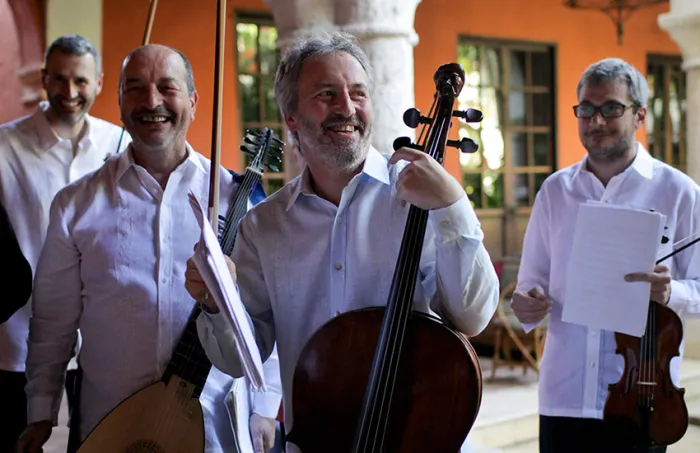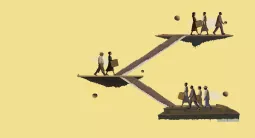Brunello's silence in te space of Cartagena

It’s about space and silence. And silence is where music is born. The Italian cellist Mario Brunello reveals the two keywords that support his special relationship with nature. Known for carrying his cello from Alps to Mount Fuji, from Sahara desert to his own garden, from prestigious concert halls in Europe, Japan and the USA to intimate chamber music venues, Brunello proves that he is more than a musician. He proves that every new venue for him is more than a place. In the early January of 2013 he arrives at the seventh Cartagena International Music Festival in Colombia to give three performances: in a chapel of Santa Tereza Hotel, in an open space of Plaza San Pedro and on the stage of Santa Clara Hotel.
Colored by light
“The first big shock is the light! Unbelievable! Everything has become light and fascinating! The country, the place.” He shares his first impressions about Cartagena at a press conference as he glances at the white walls of Claustro La Merced. “This building, this light color, the architecture is so natural. I want to add more music to this place! I want to color my music,” he keeps on admiring the space in an interview. Then, he puts on a light shirt, grabs his Maggini cello, adds the six members from Mario Brunello Quinteto and steps on a stage of Santa Clara venue.
Together they fill the space almost full with local and foreign music lovers. With Brunello’s smile and eye contact as a signal, the musicians start playing Vivaldi in unpredictable contemporary variations. From a slow, dark melancholy he suddenly jumps to fast, vivid music that breaks the silence with his vigorous cello strings. How elegantly he drags the bow in the melancholic pieces! Then he flows into a second silence. We hear the sound of paper as Brunello turns the page of the notes in front of him. Then that silence is immediately followed by a sound of organ. How suddenly he widens his eyes, frowns and fills his grimace with curiosity and infectious energy as new, faster pieces encounter his cello!
Fantastic Technology
As he turns the page to the next piece of Vivaldi, I remember the night before when he played in the open space of Plaza San Pedro to the listeners of Cartagena. The concert gathered much larger scale of audience starting from those who leant over the balconies to anyone who attended the free concert in the public space. That time it was only Brunello and the cello. Brunello started with a slow melody on the strings of his cello and added his voice to it. Giovanni Sollima’s Lamentatio turned into fast, rhythmical music bringing us quickly to the second composition – Giuseppe Colombi’s Ciaccona.
Though playing in open spaces has become a trademark of Mario Brunello, he thinks that Cartagena was not really the right place for that preferring theatres and chapels. “Every space has its tonality,” he explains having heard Cartagena’s Caribbean Sea and its people who love to talk loudly, to sing and dance in the streets. Perhaps, that’s the reason why his performance at Plaza San Pedro fills the vibrant space with everything but silence. Brunello experiments with rocky and rhythmical sounds. With the help of a sampler he makes his cello as another member of his performance letting “him” play alone even when Brunello’s hands are free and his mind pretends to be wondering where that beautiful sound comes from. “We have to use technology. If Bach had this pedal I am using, he would [have made] fantastic music!” Brunello says.
Silence shared with cello
Between the two songs he spoke Italian to an uncomprehending audience. Equally incomprehensible is imagining him as a nature lover who plays anywhere, from mountains to deserts at sunsets and sunrises. “I wanted to become a forester and understand the rhythm of nature,” he says. Perhaps, playing in nature is the way he partly fulfills his childhood dream. “I started to understand that my sound has an ability to fill up the space,” he says.
After the first trials of playing in the countryside where he grew up, he started to carry his instrument when he walked in the mountains and performed in front of the nature and music lovers. “We try to listen to the body of the sound. Because in the silence you feel that the sound has a body,” he thinks. “When a composer starts an idea, he has to stop and think and start with a silence. I like that moment,” Brunello says. He stresses the role of his cello in these special moments. “We both have the same experience to listen to that perfect silence of the mountains before the first and after the last note. So these are moments that only me and my cello know,” he says convinced that instrument has a memory.
Audience, laughs and whistles
If so, certainly his instrument will remember the end of his concert at Plaza San Pedro – Brunello leaves the stage while his Maggini is still playing and the audience laughs. Certainly, Maggini will remember the very first concert when it played Boccherini to a rather small and restricted audience at Santa Teresa. And certainly, Maggini will remember the final notes at Santa Clara when Brunello ends the concert abruptly with a few notes, embraces his cello and leaves the stage. He comes back, bows to the audience and leaves again. But the audience doesn’t want Brunello to go. The synchronized applauding succeeds in getting him back. After a mutual agreement with the audience, he repeats the last movement of Vivaldi’s concerto for cello in C major. Only then it’s time for silence: for the musicians, for Brunello and his Maggini and for the audience that slowly leaves Santa Clara. But since silence is where music is born, I hear my neighbor still whistling Brunello’s catchy variations on Vivaldi.






